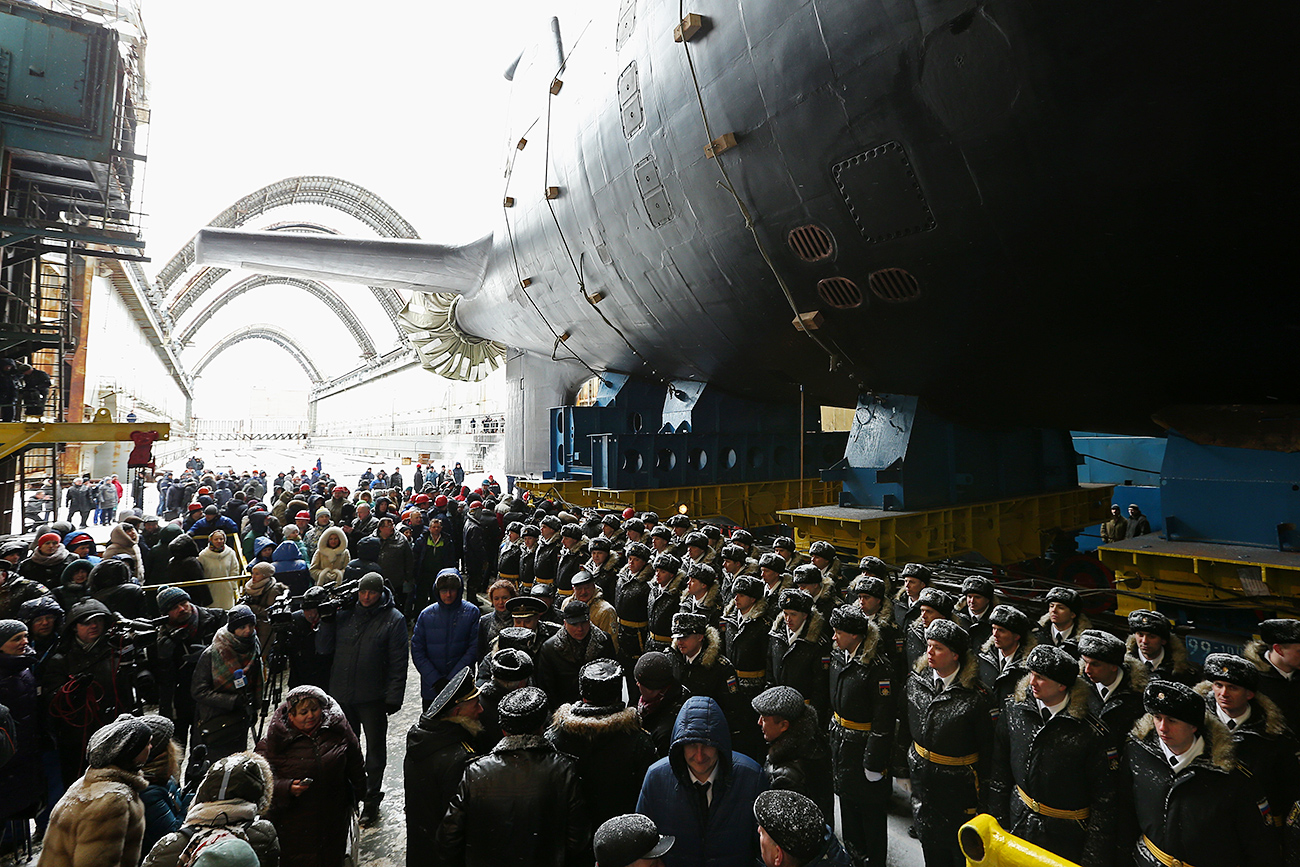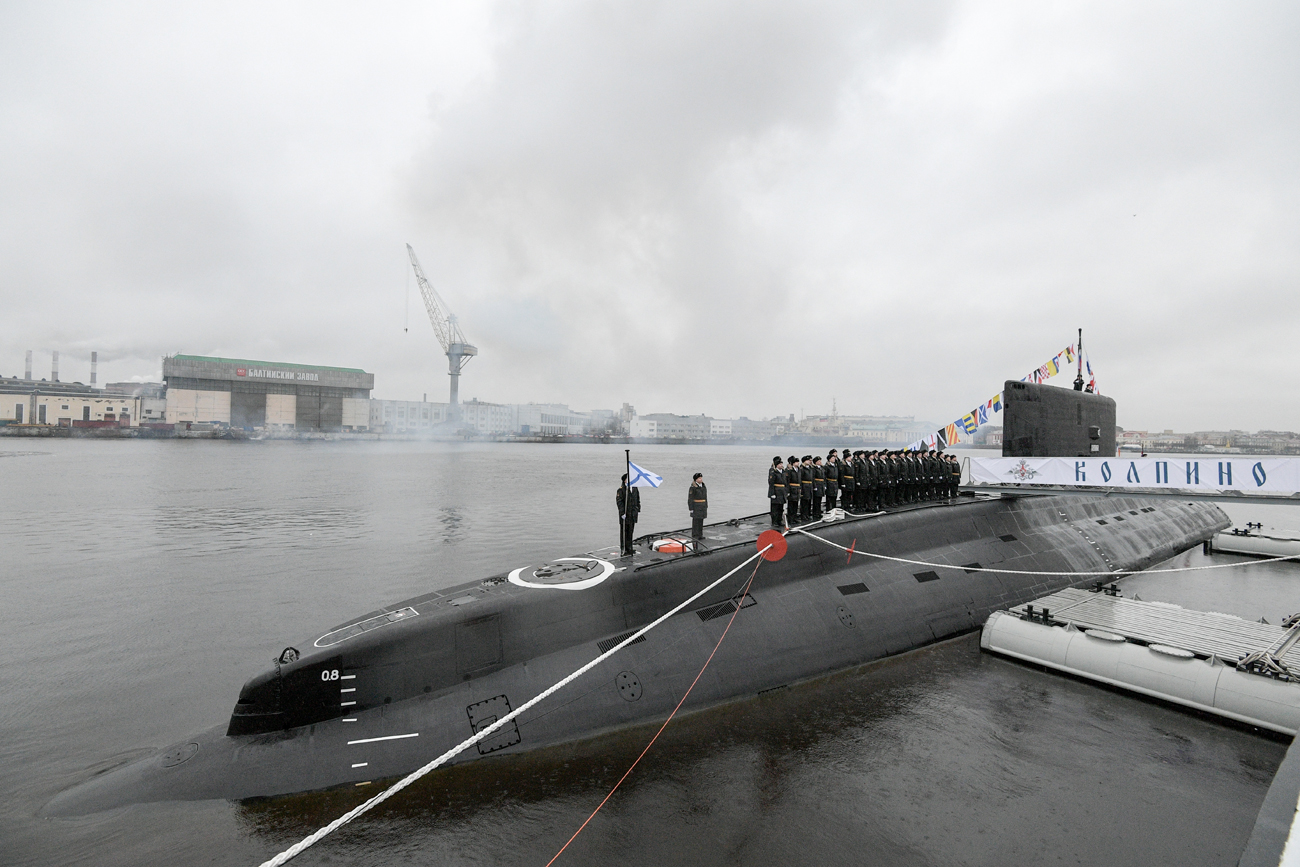The Russian Navy unleashes its most powerful and expensive attack sub

Launching the Kazan, a Project 885M Yasen-class nuclear-powered multipurpose attack submarine, at the Sevmash shipyard, March 31, 2017.
Alexander Ryumin/TASSThe siren emits a long wail and the nuclear submarine, the Kazan, slowly emerges from the workshop of Sevmash, 750 miles north of Moscow. This is Russia's largest shipbuilding company, home to Europe's largest building, with a workshop big enough to assemble as many as four nuclear submarines at once.
The Kazan comes to a halt as soon as its propeller, which is carefully camouflaged by tarpaulin and radio-absorbing panels, crosses the threshold. It stands there for a day, demonstrating to foreign reconnaissance satellites that Russia now has a new and even more lethal multipurpose attack submarine.
Neither the shipbuilders nor the military, however, explained exactly how the Kazan differs from the Severodvinsk, which is the first vessel in the Yasen class. Nikolai Novoselov, deputy director of the Malakhit Central Design Bureau, which created both the Severodvinsk and the Kazan, would only say that the Yasen-M differs from the classical Yasen thanks to more sophisticated electronic systems and weapons.
A new era in Russian nuclear subs
Since the collapse of the Soviet Union in 1991 and for the the past 25 years, the U.S. Navy enjoyed unrivaled supremacy on the seas. During that time, many subs of the former Soviet Navy were decommissioned, rusted away and were cut up for scrap. In recent years, however, Moscow has forged ahead with plans to once again make Russia a great naval power, and the destructive fire power of the Yasen class subs are precisely the threat causing the Pentagon to hit the panic button.
The Yasen class submarines are touted as perhaps the world's most silent and powerful underwater vessels. Their combat potential is often compared to that of their main opponent - the American submarines of the Virginia class, as well as the Seawolf class, which the U.S. no longer makes because of its high cost.
"The Kazan doesn't cost less than American submarines, and its price tag is about 200 billion dollars ($3.5 billion)," said Professor Vadim Kozyulin of the Academy of Military Sciences, adding that the sub's sophisticated components and electronics have no equals. Due to possible budget cuts and western sanctions, however, Moscow probably won't build many of the Yasen class subs.
"The Russian Navy should have eight Yasen submarines by 2020 as part of the military armament program, but due to the economic crisis and budget cuts, the Navy might postpone construction of the two final vessels, or not buy them at all," said Kozyulin.
What makes this sub special?
In every regard, the Yasen class is the sum of all Russian achievements over more than half a century of submarine construction. Unlike most previous Soviet submarine designs, the Yasen subs don't utilize a double hull. Instead, they have a hybrid design with a lighter structure over the vessel's pressure hull in order to reduce noise.
Also for the first time in Russian shipbuilding, the torpedo launchers are located not in the bow but at mid-ship, which allows placing a spherical sonar system in the bow.
There are eight vertical missile launchers, and the hull is made out of low-magnetic steel, which is why it can submerge 600 meters or more, (ordinary submarines cannot go beyond 300 meters). This allows it to easily escape any modern anti-submarine weapon. With one reactor, its maximum speed is more than 30 knots (35 mph).
Supersonic attack system
The section with eight vertical missile launchers is located in the central hull, and holds the Onix anti-ship cruise missiles (three in each silo). A new supersonic attack system called the Tsirkon, and based on the Onix, is currently being built for the Yasen subs.
Besides the anti-ship missiles, the Yasen subs can launch Kalibr long-distance cruise missiles, which showed their power during the Syrian campaign, when Russian navy vessels in the Caspian and Black seas used them to pound Islamic State positions. The missiles' striking distance is 1,500 miles.
The Yasen subs also have six 650mm and two 533mm torpedo tubes that can be used for any type of modern torpedo, as well as for laying mines and launching underwater drones.
Russia's new position of power
"The Kazan is capable of carrying out any task: fighting aircraft carriers, hunting down enemy submarines or conducting massive missile strikes on land targets," said Ivan Konovalov, director of the military policy and economy department at the Russian Institute of Strategic Studies.
The launch of the Kazan coincided with the "Arctic: Territory of Dialogue Forum" held March 29-30, which was attended by President Putin.
"During the forum, Moscow expressed a willingness for the region's joint development together with the West. While Putin didn't attend the Kazan's launch, most experts believe this was the only reason for the president's participation in the forum," said Konovalov.
Experts interviewed by RBTH say Putin decided not to combine the Kremlin's economic and political objectives. Deputy Prime Minister Dmitri Rogozin, however, expressed a different opinion. During the Kazan's launch ceremony he said: "Dialogue is good, but it's even better when conducted from a position of power."
Read more: Russia designing new ‘aircraft carrier killer’ torpedo to boost naval power
If using any of Russia Beyond's content, partly or in full, always provide an active hyperlink to the original material.
Subscribe
to our newsletter!
Get the week's best stories straight to your inbox
